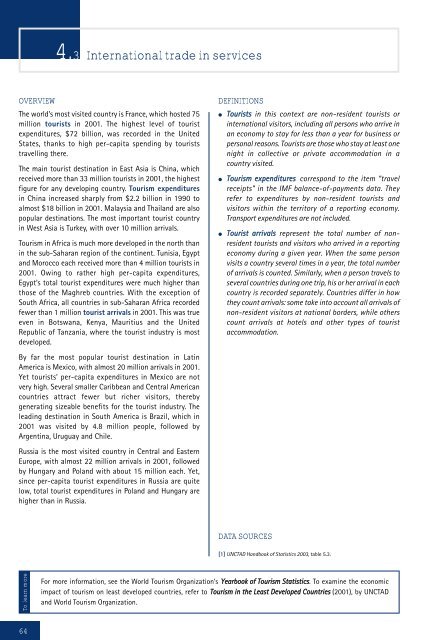Development and Globalization: - Unctad
Development and Globalization: - Unctad
Development and Globalization: - Unctad
Create successful ePaper yourself
Turn your PDF publications into a flip-book with our unique Google optimized e-Paper software.
OVERVIEW DEFINITIONS<br />
The world’s most visited country is France, which hosted 75<br />
million tourists in 2001. The highest level of tourist<br />
expenditures, $72 billion, was recorded in the United<br />
States, thanks to high per-capita spending by tourists<br />
travelling there.<br />
The main tourist destination in East Asia is China, which<br />
received more than 33 million tourists in 2001, the highest<br />
figure for any developing country. Tourism expenditures<br />
in China increased sharply from $2.2 billion in 1990 to<br />
almost $18 billion in 2001. Malaysia <strong>and</strong> Thail<strong>and</strong> are also<br />
popular destinations. The most important tourist country<br />
in West Asia is Turkey, with over 10 million arrivals.<br />
Tourism in Africa is much more developed in the north than<br />
in the sub-Saharan region of the continent. Tunisia, Egypt<br />
<strong>and</strong> Morocco each received more than 4 million tourists in<br />
2001. Owing to rather high per-capita expenditures,<br />
Egypt’s total tourist expenditures were much higher than<br />
those of the Maghreb countries. With the exception of<br />
South Africa, all countries in sub-Saharan Africa recorded<br />
fewer than 1 million tourist arrivals in 2001. This was true<br />
even in Botswana, Kenya, Mauritius <strong>and</strong> the United<br />
Republic of Tanzania, where the tourist industry is most<br />
developed.<br />
By far the most popular tourist destination in Latin<br />
America is Mexico, with almost 20 million arrivals in 2001.<br />
Yet tourists’ per-capita expenditures in Mexico are not<br />
very high. Several smaller Caribbean <strong>and</strong> Central American<br />
countries attract fewer but richer visitors, thereby<br />
generating sizeable benefits for the tourist industry. The<br />
leading destination in South America is Brazil, which in<br />
2001 was visited by 4.8 million people, followed by<br />
Argentina, Uruguay <strong>and</strong> Chile.<br />
Russia is the most visited country in Central <strong>and</strong> Eastern<br />
Europe, with almost 22 million arrivals in 2001, followed<br />
by Hungary <strong>and</strong> Pol<strong>and</strong> with about 15 million each. Yet,<br />
since per-capita tourist expenditures in Russia are quite<br />
low, total tourist expenditures in Pol<strong>and</strong> <strong>and</strong> Hungary are<br />
higher than in Russia.<br />
To learn more<br />
64<br />
4.3 International trade in services<br />
● Tourists in this context are non-resident tourists or<br />
international visitors, including all persons who arrive in<br />
an economy to stay for less than a year for business or<br />
personal reasons. Tourists are those who stay at least one<br />
night in collective or private accommodation in a<br />
country visited.<br />
● Tourism expenditures correspond to the item “travel<br />
receipts” in the IMF balance-of-payments data. They<br />
refer to expenditures by non-resident tourists <strong>and</strong><br />
visitors within the territory of a reporting economy.<br />
Transport expenditures are not included.<br />
● Tourist arrivals represent the total number of nonresident<br />
tourists <strong>and</strong> visitors who arrived in a reporting<br />
economy during a given year. When the same person<br />
visits a country several times in a year, the total number<br />
of arrivals is counted. Similarly, when a person travels to<br />
several countries during one trip, his or her arrival in each<br />
country is recorded separately. Countries differ in how<br />
they count arrivals: some take into account all arrivals of<br />
non-resident visitors at national borders, while others<br />
count arrivals at hotels <strong>and</strong> other types of tourist<br />
accommodation.<br />
DATA SOURCES<br />
[1] UNCTAD H<strong>and</strong>book of Statistics 2003, table 5.3.<br />
For more information, see the World Tourism Organization’s Yearbook of Tourism Statistics. To examine the economic<br />
impact of tourism on least developed countries, refer to Tourism in the Least Developed Countries (2001), by UNCTAD<br />
<strong>and</strong> World Tourism Organization.

















